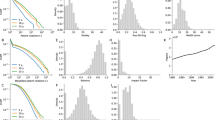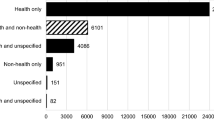Abstract
The importance of interdisciplinary research in accelerating the progress and commercialization of science is widely recognized, yet little is known about how academic research self-organizes towards interdisciplinarity. In this paper, we therefore explore the micro-level behavior of researchers as they venture into a promising space for interdisciplinary research, namely translational research—a bridge between basic and applied biomedical research. More specifically, we ask (1) whether the researchers who choose to engage in translational research have a strong scientific record, (2) how interdisciplinary research spanning basic and applied research influences the output of academic research, and (3) how different disciplinary distance in interdisciplinary research contributes to reputational benefits of researchers. We find that for some types of collaboration, interdisciplinarity results in more highly cited research, while in others it is not, and look for explanations for this difference. Our results show that translational research draws higher citations when it involves university researchers from the most basic end of the disciplinary spectrum, and when its issues are directed at basic (rather than applied) research.


Similar content being viewed by others
Notes
SCI was selected because it is the only database currently available that covers all scientific fields over several decades at a level of detail that includes all authors, their affiliations, and all cited references. Moreover, SCI is widely recognized for its excellent coverage of most medical and biological sciences. Moed (2006). Citation Analysis in Research Evaluation, Springer.
Basing searches on full publication lists provided by the departments themselves is recognized as the most accurate and complete starting point for the collection of publication data. Ibid.
We also controlled for the number of years for which each researcher had been employed during the period of study. However, the variable was excluded, as it had no significant relationship to the number of collaborations undertaken with hospitals.
It should be noted that authors in the data set have not yet been matched with organizational affiliations. As such, our indicator of collaboration may in some instances reflect multiple affiliations of single authors.
This finding raises the question of whether NAT-hospital collaborations tend to receive higher numbers of citations because their joint, interdisciplinary efforts have a positive impact on the quality of subsequent research results or simply because highly cited NAT researchers engage in these collaborations and attract higher citation numbers. As mentioned in Sect. 3, we are currently working on linking our individual-level and publication-level databases to allow for more sophisticated analysis of the issues raised in the paper. However, to address the aforementioned question, we ran the regressions presented in Table 9 using a preliminary control variable, namely, the average number of citations per publication for the most highly cited co-author from the department in question. Although further work is needed to refine this control, our preliminary analysis had no significant impact on our primary findings.
References
Ahuja, G. (2000). Collaboration networks, structural holes, and innovation: A longitudinal study. Administrative Science Quarterly, 45(3), 425–457.
Audretsch, D., Bozeman, B., et al. (2002). The economics of science and technology. Journal of Technology Transfer, 27(2), 155–203.
Bast, R., Mills, G., et al. (2001). Translational research—Traffic on the bridge. Biomedicine and Pharmacotherapy, 55(9–10), 565–571.
Brusoni, S., Criscuolo, P., & Geuna, A. (2005). The knowledge bases of the world’s largest pharmaceutical groups: What do patent citations to non-patent literature reveal? Economics of Innovation and New Technology, 14(5), 395–415. doi:10.1080/1043859042000307356.
Cambrosio, A., Keating, P., Mercier, S., Lewison, G., & Mogoutov, A. (2006). Mapping the emergence and development of translational cancer research. European Journal of Cancer, 42(18), 3140–3148.
Corley, E., Boardman, P., & Bozeman, B. (2006). Design and the management of multi-institutional research collaborations: Theoretical implications from two case studies. Research Policy, 67(8), 975–993.
Dasgupta, P., & David, P. (1994). Toward a new economics of science. Research Policy, 23(5), 487–521.
David, P., Mowery, D., et al. (1994). Analyzing the economic payofs from basic research. In D. C. Mowery (Ed.), Science and technology policy in interdependent economies. Boston: Kluwer Academic Publishers.
Defila, R., & Di Giulio, A. (1996). Voraussetzungen zu interdisziplinarem Arbeiten und Grundlagen ihrer Vermittlung. Basel: Birkhauser.
Fricker, J. (2007). Translational cancer research in Europe. Molecular Oncology, 1(1), 8–10.
Gelijins, A., & Thier, S. (2002). Medical innovation and institutional interdependence: Rethinking university-industry connections. Journal of the American Medical Association, 287(1), 72–77.
Gowanlock, M., & Gazan, R. (2013). Assessing researcher interdisciplinarity: A case study of the University of Hawaii NASA Astrobiology Institute. Scientometrics, 94(1), 133–161.
Grundfeld, E., Zitzelsberger, L., Evans, W., Cameron, R., Hayter, C., Berman, N., & Stern, H. (2004). Better knowledge translation for effective cancer control: A priority for action. Cancer Causes and Control, 15(5), 503–510.
Hagedoorn, J. (1993). Understanding the rationale of strategic technology partnering: Interorganizational modes of coorporation and sectoral differences. Strategic Management Journal, 14(5), 371–385.
Jensen, R., & Thursby, M. (2001). Proofs and prototypes for sale: The licensing of university inventions. American Economic Review, 91(1), 240–259.
Khoury, M., Gwinn, M., et al. (2007). Will genomics widen or help heal the schism between medicine and public health? Americal Journal of Preventive Medicine, 33(4), 310–317.
Lauto, G., & Valentin, F. (2010). The Emergence of translational research. Patterns in its current advances. In Proceedings from the Eleventh International Conference on Science and Technology Indicators, Leiden, The Netherlands, 9–11 September 2010.
Leydesdorff, L., & Rafols, I. (2009). A global map of science based on the ISI subject categories. Journal of the American Society for Information Science and Technology, 60(2), 348–362.
Llerena, P., & Meyer-Krahmer, F. (2003). Interdisciplinary research and the organization of the university: General challenges and a case study. In A. Geuna, A. J. Salter & W. E. Steinmueller (Eds.), Science and innovation: Rethinking the rationales for funding and governance (pp. 80–81). Cheltenham: Edward Elgar.
Mayer, L. (2002). The real meaning of translational research. Gastroenterology, 123(3), 665.
Moed, H. F. (2006). Citation analysis in research evaluation (Vol. 9). Springer.
Moran, N. (2007). Public sector seeks to bridge ‘valley of death’. Nature Biotechnology, 25(3), 266.
Mowery, D. (1999). US Industry in 2000: Studies in competitive performance. Washington, DC: National Academy Press.
Nooteboom, B., Van Haverbeke, W., Duysters, G., Gilsing, V., & van den Oord, A. (2007). Optimal cognitive distance and absorptive capacity. Research Policy, 36(7), 1016–1034.
Porter, A. L., & Rafols, I. (2009). Is science becoming more interdisciplinary? Measuring and mapping six research fields over time. Scientometrics, 81(3), 719–745.
Powell, W., Koput, K., et al. (1996). Interorganizational collaboration and the locus of innovation: Networks of learning in biotechnology. Administrative Science Quarterly, 41(1), 116–145.
Rosenkopf, L., & Almeida, P. (2003). Overcoming Local Search through Alliances and Mobility. Strategic Management Journal, 49(6), 751–766.
Rosenkopf, L., & Nerkar, A. (2001). Beyond local seach: Boundary-spanning, exploration, and Impact in the optical disc industry. Strategic Management Journal, 22(4), 287–306.
Sartor, R. (2003). Translational research: Bridging the widening gap between basic and clinical research. Gastroenterology, 124(5), 1178.
Scherer, F. (1999). New perspectives on economic growth and technological innovation. Washington: Brookings Institution Press.
Schmoch, U., Hinze, S., Jäckel, G., Kirsch, N., Meyer-Krahmer, F., & Münt, G. (1996). The role of the scientific community in the generation of technology. In G. Reger & U. Schmoch, (Eds.), Organisation of Science and Technology at the Watershed (Vol. 3, pp. 1–138). Physica-Verlag HD.
Sultana, S., Roblin, D., et al. (2007). Translational research in the pharmaceutical industry: From theory to reality. Drug Discovery Today, 12(9), 419–425.
Tijssen, R. (1992). A quantitative assessment of interdisciplinary structures in science and technology: Co-classification analysis of energy research. Research Policy, 21(1), 27–44.
van Leeuwen, T., & Tijssen, R. (2000). Interdisciplinary dynamics of modern science: analysis of cross-disciplinary citation flows. Research Evaluation, 9(3), 183–187.
Zerhouni, E. (2005). Translational and clinical science—Time for a new vision. New England Journal of Medicine, 353(15), 1621–1623.
Acknowledgments
In developing the ideas for this paper, the authors benefited from discussions with Christian Knudsen, Ishmael Rafols, and Martin Meyer.
Author information
Authors and Affiliations
Corresponding author
Rights and permissions
About this article
Cite this article
Valentin, F., Norn, M.T. & Alkaersig, L. Orientations and outcome of interdisciplinary research: the case of research behaviour in translational medical science. Scientometrics 106, 67–90 (2016). https://doi.org/10.1007/s11192-015-1784-2
Received:
Published:
Issue Date:
DOI: https://doi.org/10.1007/s11192-015-1784-2
Keywords
- Interdisciplinary research
- Cognitive distance
- Basic and applied science
- Cost of learning
- Translational research




